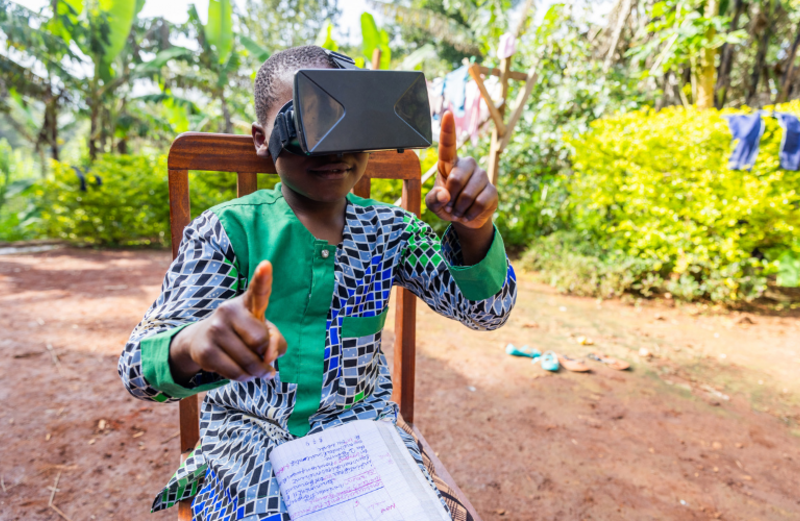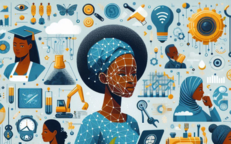Transforming Africa’s Education Using Augmented Reality Technology

This is the 3rd post in a blog series to be published in 2024 by the APET Secretariat on behalf of the AU High-Level Panel on Emerging Technologies (APET)
The African Union (AU) has made education a priority for 2024, adopting the theme "Educate an African Fit for the 21st Century – Building Resilient Education Systems for Increased Access to Inclusive, Lifelong, Quality, and Relevant Learning in Africa.”[1] This initiative recognizes education as both a fundamental human right and a crucial driver for the continent's progress. The AU aims to achieve sustainable benefits such as developing a skilled workforce, enhance social cohesion, encourage innovation, and build resilient communities through investment in education.[2]
The pivotal role of education is underscored in the African Union’s overarching development vision, the AU Agenda 2063, and the Continental Education Strategy for Africa (CESA 2016-2025).[3] It is seen as key to increasing Africa's human capital, driving socioeconomic growth, breaking the cycle of poverty, and preparing a workforce that is adaptable to the changing demands of the job market.
AU Member States have made remarkable strides in enhancing the standard of education across the continent. To ensure and guarantee universal access to education, African governments have implemented various initiatives and enacted substantial regulatory reforms to guarantee equitable access to quality primary education for all. These measures encompass implementing free primary education in select countries, enforcing compulsory primary education, and a heightened focus on teacher training, including integrating digital pedagogical skills.[4]
These efforts have yielded significant results, exemplified by the reduction in the proportion of out-of-school children from 35% in 2000 to 17% in 2019.[5] Furthermore, over the past two decades, there has been a notable decline in the percentage of children not attending school, dropping from 43% to 33% for lower secondary school-age children, and from 63% to 53% for upper secondary school-age children.[6]
However, despite the significant strides made in the education sector across the continent, there remain notable challenges impeding further progress. For instance, as of 2019, it was reported that 105 million children, encompassing both primary and secondary levels, were not enrolled in school. Additionally, nearly 87% of children in Africa struggle to read and comprehend simple texts by the age of 10. In 2019, the average TVET enrolment rate in Africa was 762 per 100,000 individuals, compared to the global average of 801 students.[7] Despite the field’s ongoing growth and accompanying constraints, numerous African countries remain committed to expanding technical and vocational education, and training (TVET). Furthermore, Africa is grappling with a severe shortage of qualified teachers.[8] It is projected that by 2030, the continent will need an additional 17 million teachers to ensure universal access to primary and secondary education.
Given these challenges, there's a strong case for adopting advanced technologies like augmented reality (AR) to address educational barriers. AR can revolutionize learning by providing immersive experiences that make education more accessible, engaging, and relevant to students across Africa. This aligns with the AU's focus on building a resilient education system that caters to the evolving needs of its population and contributes to socio-economic development across the continent.[9]
The African Union High-Level Panel on Emerging Technologies (APET) is advocating for the adoption of advanced technologies such as AR to improve the standard of education across the continent. Particularly, AR as it involves the real-time integration of textual, graphical, auditory, and virtual enhancements with tangible real-world elements. By superimposing digital content onto physical environments and objects,[10] AR offers an immersive learning experience that can be accessed through various devices such as smartphones, tablets, smart glasses, and headsets. This technology is particularly promising in Africa, where access to educational resources has historically been limited, offering a new avenue to transform educational delivery and engagement.
AR facilitates inclusive education by catering to diverse learning needs. For example, students with visual impairments benefit from AR apps with audio descriptions, while those with dyslexia find support through highlighted text and interactive features. AR breathes life into complex biological systems, enabling students to manipulate organs, scrutinize details, and deepen comprehension. Additionally, AR transforms passive learning into active exploration, igniting curiosity and enhancing engagement. Consider the scenario of students in rural Ghana, accustomed to static diagrams, delving into the intricacies of human anatomy through a 3D model projected onto their desks. Similarly, envision history unfolding before the eyes of South African learners as they engage with AR applications, witnessing historical events virtually, and creating emotional connections that solidify their understanding of the past.
[11] Picture students in Nigeria virtually dissecting a frog, manipulating its digital organs, and observing real-time functions, which is an immersive, hands-on experience that fosters curiosity and bolsters information retention.
Across Africa, initiatives like Rwanda's "Ubongo" are pioneering the use of augmented reality (AR) technologies in education. Established in 2014, Ubongo is a Rwandan social enterprise leading the charge to integrate AR into learning, aiming to improve educational outcomes for children through immersive and interactive experiences.[12] Their efforts include developing AR applications aligned with the Rwandan curriculum in subjects like mathematics, science, and Kinyarwanda, along with historical and cultural content. Furthermore, Ubongo provides comprehensive training for teachers to effectively utilize AR in their classrooms and collaborates with schools, Non-Governmental Organisations (NGOs), and government entities to distribute AR solutions to students nationwide, sometimes offering affordable devices pre-loaded with their applications.
Ubongo's AR initiatives have led to significant benefits, such as increased student engagement, enhanced learning outcomes, empowered teachers, and greater accessibility, particularly for students in remote areas or living with disabilities.[13] Achievements include reaching over 500,000 students, over 2 million application downloads, and receiving prestigious awards like the World Summit Award for Education and the WISE Award. Despite challenges like technological costs and the need for culturally relevant content, Ubongo's innovative AR use continues to advance education in Rwanda.
In Kenya, for example, "AR Animals" exemplifies the country's innovative use of AR in education, offering virtual safaris and wildlife conservation simulations.[14] A variety of investments from both startup companies and organisations, as well as government and NGOs, have propelled the adoption of AR applications in this field.[15] These initiatives yield numerous benefits, including enriched learning through interactive experiences, increased accessibility for students in remote areas, heightened conservation awareness, promotion of tourism, and enhanced training for wildlife protection.[16]
Notable outcomes include reaching millions of users globally, improving learning outcomes for children, reducing poaching incidents, and boosting the local economy through increased tourist interest. AR technology’s focus on visualizing animals in their natural surroundings fosters immersive and interactive experiences that surpass traditional methods, while challenges such as accessibility and content relevance necessitate ongoing development and investment.[17] In the future, the versatile capabilities of “AR animals” highlight their potential to transform education, conservation initiatives, and tourism, extending beyond Kenya to impact wider societal arenas. This example serves as a testament to the transformative impact of AR technology in enriching diverse experiences within educational, environmental, and cultural spheres.
Looking forward, although obstacles concerning technology access remain prevalent in specific regions, initiatives such as the “Digital Divide Data” are actively identifying connectivity gaps, paving the way for widespread AR integration. Embracing AR unlocks a spectrum of opportunities for African learners, enabling them to assume control of their education journey and navigate towards a more promising future.[18] As AR technology advances and becomes increasingly accessible, its capacity to transform education in Africa becomes increasingly profound.
APET urges policymakers to bridge the digital divide in schools, a crucial step for adopting AR and enhancing education continent-wide. APET asserts that resolving this gap is crucial for African schools to fully embrace the educational potential outlined in the AU’s 2024 education theme. To achieve this, APET advocates for Ministries of Education to implement innovative teaching and methods that extend access to online learning resources for all children, particularly those who are disadvantaged and vulnerable. This requires strategic partnerships with telecommunications companies and internet providers to reduce the cost of airtime, mobile data, and broadband services. Inter-ministerial cooperation between the Ministries of Education and Telecommunications is essential, along with investments in strategic alliances and Information and Communication Technology (ICT) infrastructure.[19]
Efforts to address constraints of the AR technology should be guided by a clearly defined roadmap and fostered through inter-ministerial collaboration, reinforced by national frameworks for both ICT and education policy. For instance, Richard Varha Technical High School in South Africa serves as a prime example of leveraging emerging technology, particularly AR, to enhance the learning experience. This innovative approach is embodied in the unveiling of the first South African Extended Reality (XR) public school classroom based on AR.[20] Generously donated by XR EdTech company Nudle and Chinese VR Tech education giant KMAX, this initiative reflects their commitment to revolutionizing education in Africa. Through this technology, Richard Varha Technical High School has cultivated interactive and immersive learning environments, enabling students to engage with instructional content in dynamic ways.[21] For example, students now have access to AR applications that offer 3D models to explore complex concepts in biology, chemistry, and physics. This integration of technology has contributed to the school’s status as one of the top performers in South Africa, facilitating practical workshop exercises without the need for physical equipment and fostering a secure and captivating learning atmosphere.[22]
In conclusion, as Africa stands on the brink of embracing the benefits of AR, it is critical for education policymakers to assess the technology’s potential applications comprehensively. By developing new context-specific AR-based applications to inspire and enhance learning, future generations can progress toward realizing the goals of the AU’s Agenda 2063. APET urges AU Member States to integrate AR technology into their educational systems to improve teaching methods and enrich learning experiences continent-wide. Embracing AR in education is an investment that promises to propel the African countries toward achieving universal education.
Featured Bloggers – APET Secretariat
Aggrey Ambali
Justina Dugbazah - The Sahara Institute
Barbara Glover
Bhekani Mbuli
Chifundo Kungade
Nhlawulo Shikwambane
[1] https://au.int/en/newsevents/20240216/pre-launch-african-union-theme-2024
[2] https://www.unesco.org/sdg4education2030/en/articles/podcast-education-african-union-theme-year-2024
[3] https://au.int/sites/default/files/documents/43425-doc-CONCEPT_NOTE_with_Roadmap_AU_Theme_Eng_VF.pdf
[4] https://au.int/en/newsevents/20231114/innovating-education-africa-2023-policy-dialogue-exhibition-and-campaign-digital
[5] https://uis.unesco.org/sites/default/files/documents/fs48-one-five-children-adolescents-youth-out-school-2018-en.pdf
[6] https://www.unicef.org/media/106691/file/Transforming Education in Africa.pdf
[7]https://www.uneca.org/sites/default/files/TCND/ARFSD2022/Background/Sustainable Development Goal Ensure inclusive%20and equitable quality education and promote lifelong learning opportunities for all by EN.pdf
[8] https://www.imf.org/external/pubs/ft/issues/issues33/
[9] Mhlanga, David. (2020). Industry 4:0 The Challenges Associated with the Digital Transformation of Education in South Africa.
[10] https://www.sap.com/products/scm/industry-4-0/what-is-augmented-reality.html#:~:text=Augmented%20reality%20definition,real%2Dlife%20environments%20and%20objects.
[11] Kazoka, D.; Pilmane, M.; Edelmers, E. Facilitating Student Understanding through Incorporating Digital Images and 3D-Printed Models in a Human Anatomy Course. Educ. Sci. 2021, 11, 380. https://doi.org/10.3390/educsci11080380
[12] https://utbildningsfonden.files.wordpress.com/2020/09/ela_report_2019_18mb.pdf
[13] https://www.ubongo.org/impacts/
[14] https://techcrunch.com/2017/11/20/internet-of-elephants/
[15] Yılmaz, Zeynel & Gözüm, Ali Ibrahim Can. (2023). Augmented Reality App in Preschool Education: Children's Knowledge About Animals. Southeast Asia Early Childhood Journal. 12. 130-151. 10.37134/saecj.vol12.2.8.2023.
[16]https://techcrunch.com/2017/11/20/internetelephants/?guccounter=1&guce_referrer=aHR0cHM6Ly93d3cuZ29vZ2xlLmNvbS8&guce_referrer_sig=AQAAAAbyY083PlKYgXZmCsmLWtJIXyxuAT2mIGH7COXVyKEJlbCjSNEy_s9bBjXWhrroJBjiqgdwmpxWNmxyHUCtXrxHts2_Dp5JJ9PwgYKsqAtN8bts6b7QLAHasnIwwaD7J-FZEEdbqEU4l3Flz5UIzQBnIrl7KyQrT2est-ZNeFak
[17] https://rockpaperreality.com/insights/ar-use-cases/augmented-reality-in-tourism-and-travel/
[18] https://fastercapital.com/topics/the-role-of-accessible-technology-startups-in-bridging-the-digital-divide:the-importance-of-accessibility-in-the-digital-age.html
[19] https://www.afrobarometer.org/wp-content/uploads/migrated/files/publications/Policy papers/pp66-africas_digital_divide_and_the_promise_of_e-learning-afrobarometer_policy_paper-14june20.pdf
[20] https://techcabal.com/2023/03/23/extended-reality-school-sa/
[21] https://techcabal.com/2023/03/23/extended-reality-school-sa/
[22] https://www.isolezwelesixhosa.co.za/english/dimbaza-school-gets-technology-upgrade-e70309f3-aa5c-4c97-9ea3-8ad1d8c5d310/


